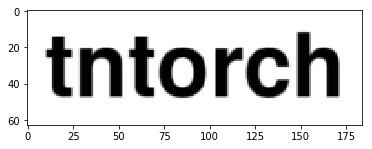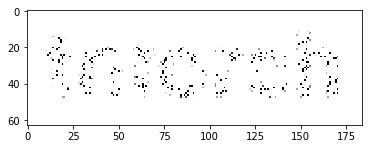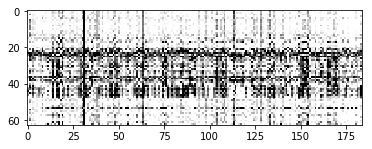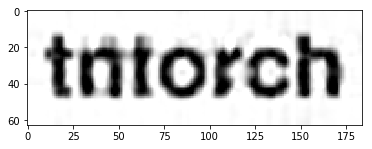Tensor Completion¶
Completing a tensor means filling out its missing values. It’s the equivalent of interpolation for the case of discretized tensor grids.
[9]:
import torch
import tntorch as tn
import numpy as np
%matplotlib inline
import matplotlib.pyplot as plt
We will start by reading a text image and masking out 90% of its pixels:
[10]:
im = torch.DoubleTensor(plt.imread('../images/text.png'))
plt.imshow(im, cmap='gray', vmin=im.min(), vmax=im.max())
plt.show()
P = im.shape[0]*im.shape[1]
Q = int(P/10)
print('We will keep {} out of {} pixels'.format(Q, P))
X = np.unravel_index(np.random.choice(P, Q), im.shape) # Coordinates of surviving pixels
y = torch.Tensor(im[X]) # Grayscale values of surviving pixels

We will keep 1159 out of 11592 pixels
The masked image looks like this:
[11]:
mask = np.ones([im.shape[0], im.shape[1]])
mask[X] = y
plt.imshow(mask, cmap='gray', vmin=im.min(), vmax=im.max())
plt.show()

Now, we will try to recover the image by completing a rank-6 tensor with those samples:
[12]:
t = tn.rand(im.shape, ranks_tt=6, requires_grad=True)
def loss(t):
return tn.relative_error(y, t[X])
tn.optimize(t, loss)
plt.imshow(t.numpy(), cmap='gray', vmin=im.min(), vmax=im.max())
plt.show()
iter: 0 | loss: 1.178050 | total time: 0.0009
iter: 500 | loss: 0.200007 | total time: 0.5207
iter: 1000 | loss: 0.084521 | total time: 1.0735
iter: 1500 | loss: 0.021333 | total time: 1.6547
iter: 2000 | loss: 0.003651 | total time: 2.2765
iter: 2187 | loss: 0.001562 | total time: 2.5357 <- converged (tol=0.0001)

The result is not convincing since we are not using any notion of spatial correlation: the real world signal is smooth, but our tensor does not know about that.
Smoothness Priors¶
This time we will add a penalization term in the hope of getting a smoother reconstruction. We will use the norm of the tensor’s 2nd-order derivatives, for which we can use the function *partialset()*. To combine (add) both losses, we need to return them as a tuple from the loss() function:
[13]:
t = tn.rand(im.shape, ranks_tt=6, requires_grad=True)
def loss(t):
return tn.relative_error(y, t[X])**2, tn.normsq(tn.partialset(t, order=2))*1e-4
tn.optimize(t, loss)
plt.imshow(t.numpy(), cmap='gray', vmin=im.min(), vmax=im.max())
plt.show()
iter: 0 | loss: 1.172050 + 2.569117 = 3.741 | total time: 0.0037
iter: 500 | loss: 0.120569 + 0.085111 = 0.2057 | total time: 2.4681
iter: 1000 | loss: 0.063130 + 0.021324 = 0.08445 | total time: 4.9900
iter: 1500 | loss: 0.053652 + 0.010877 = 0.06453 | total time: 7.6926
iter: 2000 | loss: 0.046964 + 0.008748 = 0.05571 | total time: 10.2740
iter: 2500 | loss: 0.037407 + 0.008513 = 0.04592 | total time: 12.8340
iter: 3000 | loss: 0.025241 + 0.007971 = 0.03321 | total time: 15.2129
iter: 3500 | loss: 0.015514 + 0.006649 = 0.02216 | total time: 17.7566
iter: 4000 | loss: 0.010046 + 0.005578 = 0.01562 | total time: 19.9821
iter: 4500 | loss: 0.006938 + 0.005028 = 0.01197 | total time: 22.7111
iter: 5000 | loss: 0.005096 + 0.004723 = 0.009818 | total time: 25.3216
iter: 5500 | loss: 0.004118 + 0.004510 = 0.008628 | total time: 28.6819
iter: 6000 | loss: 0.003574 + 0.004364 = 0.007938 | total time: 33.3063
iter: 6500 | loss: 0.003203 + 0.004258 = 0.007461 | total time: 37.6611
iter: 6542 | loss: 0.003178 + 0.004251 = 0.007429 | total time: 38.1314 <- converged (tol=0.0001)
